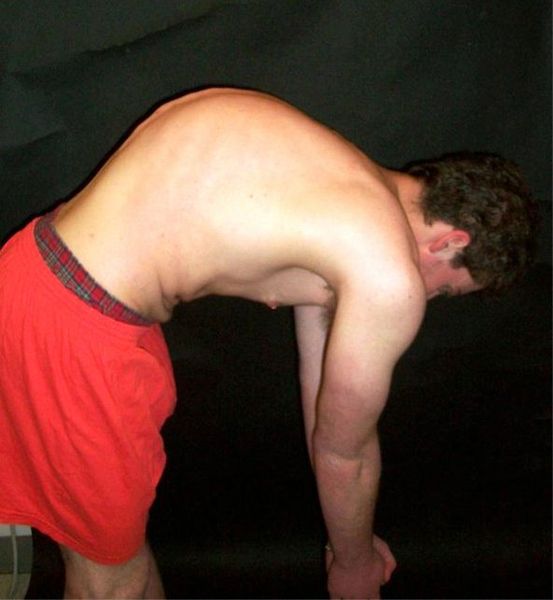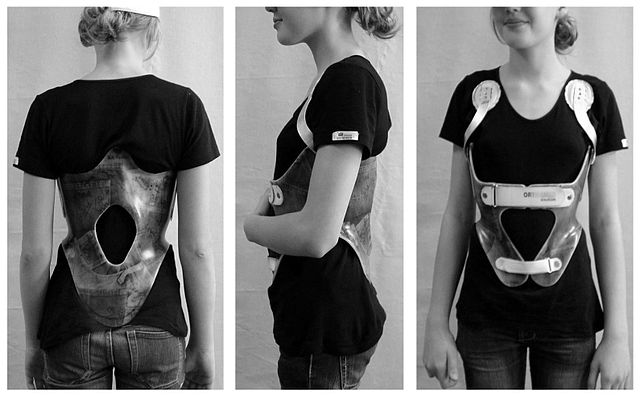Enhance your health with free online physiotherapy exercise lessons and videos about various disease and health condition
Kyphosis Treatment
Physical therapy is important for kyphosis treatment. It's especially useful for cases of postural kyphosis because a physical therapist can help correct posture and strengthen spinal muscles. However, physical therapy may also be recommended for patients with structural kyphosis, including Scheuermann's kyphosis and kyphosis caused by spinal fractures.
Kyphosis
Kyphosis is an abnormal posterior curve, usually found in the thoracic region of the spine. As such, it is an exaggeration of the normal posterior curve. If used without any modifying word, it refers to a thoracic kyphosis. In the low back, there is, occasionally, a lumbar kyphosis which is a reversal of the normal anterior curve.
Since kyphosis is natural in the spine, we have to identify what excessive kyphosis is, which is generally the problem. Generally speaking, a normal for a thoracic kyphotic curve measures between 30 to 35°. In excessive kyphosis would be greater than 35°.
Rounded Back or Increased Kyphosis

This posture is characterized by an increased thoracic curve, protracted scapulae (round shoulders), and usually an accompanying forward head.
Potential Sources Of Pain
- Stress on posterior longitudinal ligament.
- Fatigue of the thoracic erector spinae and scapular retractor muscles.
- Thoracic outlet syndrome
- Cervical posture syndromes
Potential Muscle Impairments
- Decreased flexibility in the muscles of the anterior thorax (intercostal muscles), muscles of the upper extremity originating on the thorax (pectoralis major and minor, latissmus dorsi, and serratus anterior), muscles of the cervical spine and head attached to the scapula (levator scapulae and upper trapezius), and muscles of the cervical region.
- Stretched and weak thoracic erector spinae and scapular retractor muscles (rhomboids and middle trapezius).
Faulty upper quadrant posture leads to an imbalance in the length and strength of the scapular and glenohumeral musculature and decreases the effectiveness of the dynamic and passive stabilizing structures of the Glenohumeral(GH) joint. Typically with increased thoracic kyphosis, the scapula is protracted and tipped forward, and the GH jointis in an internally rotated posture. With this posture, the pectoralis minor, levator scapulae, and the shoulder internal rotators are tight, and the lateral rotators of the shoulder and upwards rotators of the scapula test weak and have poor muscular endurance. There is no longer the stabilizing tension on the superior joint capsule and the coracohumeral ligament or compressive forces from the rotator cuff muscles. Therefore, the effect of gravity tends to cause an inferior force on the humerus.
Common Causes of Kyphosis are
- Postural-It is usually seen in tall individuals. Bad posture in school or mental and physical tension can also lead to faulty posture.
- If due to some reason, there is exaggeration of lumbar lordosis then there is compensatory kyphosis in the thoracic spine.
- Kyphosis may result due to Scheurmann's disease which is the osteochondritis of the vertebral bodies.
- Ankylosing spondylitis is another major cause of kyphosis. It produces a stiff kyphotic spine.
- In adolescent age group, it may be due to arthritis or rheumatism.
Classifications of Kyphosis
- Postural
- Scheuermann's
- Congenital
- Neuromuscular
- Myelomeningocele
- Traumatic
- Post-surgical
- Post-irradiation
- Metabolic
- Skeletal dysplasias
- Collagen disease
- Tumor
- Inflammatory
Scheuermann's Kyphosis
- A thoracic kyphosis of more than 40°
- Three or more adjacent vertebra that are wedged 5°
- Characterized by schmorl’s nodes, irregular endplates, and a narrowing of verterbral disc space.
- Increased veterbral anterior/posterior diameter at the apex
Kyphosis can be manifest as part of the clinical picture of a number of generalized conditions. Children with high-level myelodysplasia generally develop lumbar kyphosis due to the absence of posterior structures. Two of the more malevolent mucopolysaccaridoses, Hunter and Hurler syndromes, may present with kyphosis in infancy. Thoracolumbar kyphosis also commonly affects infants with achondroplasia. Fortunately, most resolve with walking. Other unusual causes include Gaucher's disease, juvenile osteoporosis, and pseudoachondroplasia. Kyphosis in conditions accompanied by ligamentous laxity such as Ehlers Danlos syndrome and Marfan syndrome commonly affect the thoracolumbar or lumbar spine. Lumbar or thoracolumbar kyphosis is difficult to treat as junctional kyphosis above or below the instrumented portion of the spine often occurs unless excellent sagittal plane alignment is achieved. Kyphosis accompanying neurofibromatosis often is accompanied by severe rotatory deformity and can be very difficult to treat. Cervical kyphosis can be a part of diastrophic dysplasia or Larsen's syndrome . In parts of the world, where tuberculosis is prevalent, screening of children for kyphosis can aid earlier diagnosis. As children with cystic fibrosis live longer into adult life, kyphosis accompanying this condition is more often being reported. For conditions such as juvenile osteoporosis or Maroteaux-Lamy syndrome, in which the kyphosis is flexible and radiographically corrects when the patient is placed supine over a bolster, bracing can be effective.
Clinical Findings
- An adult presenting with low back pain or a teenager with poor posture with or without pain
- Physical examination usually reveals a sharp, rigid kyphosis
- Kyphosis is increased with flexion and incompletely corrected with extension
- Lumber hyperlordosis, increased pelvic tilt and associated hamstring tightness
- Sagittal plumb line should cross C7-T1, T12-L1, and posterior sacrum normally
- Normal thoracic kyphosis : 30º-40º, mean = 34º
- Normal lumbar lordosis : 55º-65º(two-thirds of lordosis at L4-L5 and L5-S1)
- Lumbar lordosis should be about 30ºgreater than thoracic kyphosis
- 30% have associated mild scoliosis.
According to the severity and the extent of disease, there are three degrees:-
- 1-First degree
- 2-Second degree
- 3-Third degree
Kyphosis Treatment
Early diagnosis help prevent the progression of the severity. Treatment is given according to the degree of deformity. Its important to realize, however, that correction of kyphotic posture takes time. It involves exercises, stretches, mobilizations, as well as continual postural correction.
First Degree Kyphosis Treatment
It is usually due to poor posture. Postural Kyphosis Treatment include certain physical therapy exercises to strengthen the patient's paravertebral muscles. Further, the patient must make a conscious effort to work toward correcting and maintaining proper posture.
- Whole relaxation of the body is done.
- Using mirror, the patient is made aware of his poor posture and proper instructions are given accordingly to correct the posture.
- Mobilizing exercises are given for whole spine.
- Strengthening exercises are given for abdominal muscles and back extensors.
- There may be associated tightening in hamstring muscles. Hence stretching of hamstring is done.
- Breathing exercises especially diaphragmatic and lateral costal breathing are taught to the patient.
- Gluteal and abdominal contractions are also very useful.
Kyphosis Treatment-Stretches
While it is essential to strengthen the muscles that are causing the slouching of the thoracic spine to occur, it is also important to stretch the muscles that are holding the postural dysfunction in place. Two muscles that can significantly contribute to excess thoracic flexion include the abdominals, as well as the diaphragm.
Abdominal stretching: Stretching your abs can help tremendously in reducing thoracic kyphosis, because at the same time you stretch them, you are mobilizing your spine. One of the best ways to stretch your abs is by laying over a swiss ball. Its important to make sure you relax as you do this stretch, and breath naturally, as this will serve to improve the release you get.
Foam rolling the thoracic spine: This technique involves laying over a foam roll, for the purpose of mobilizing your spine. Basically this means stretching it backwards over the roll. This technique can be quite tender on your spine at first, particularly at those spinal segments that are not moving very well, but can improve quickly over about 2 weeks with consistent work on the roller.

Second and third Degree Kyphosis Treatment
The Deformity is in advanced stage. Hence to correct it brace is given to the patient. Along with bracing, exercises also play role in improving mobility of the spine.
Physical Therapy in Scheuermann's Kyphosis Treatment
Physical therapy is often used at the same time as bracing. Because the brace supports so much of the spine, some believe that wearing the brace can weaken the muscles. Physical Therapy help avoid this. Otherwise, when the brace comes off, the muscles may not be able to support the spine very well, and the spine may still curve too much.
The physical therapist also help with flexibility and range of motion. Many patients with Scheuermann's kyphosis also have very tight hamstring muscles. Physical therapy can help alleviate those tight muscles.
Physical Therapy in Kyphosis Treatment Caused by Spinal Fractures
Physical therapy won't correct the kyphotic curve caused by spinal fractures, but to prevent more fractures, it may be useful to learn good (or better) posture. A physical therapist can also help strengthen spinal muscles so that spine is better supported—taking some of the weight and pressure off vertebrae.
A physical therapist can also help with safe exercises. Exercise is important to bone health, so a PT can develop an exercise plan that may involve weight-bearing exercises (such as walking or tennis) and strengthening exercises (such as weight lifting).
Surgical Procedure for Structural Kyphosis Treatment
The surgical procedure for structural kyphosis treatment involves halo traction for several weeks. In some cases, bone graft may be required to maintain the correction. Sometimes spinal decompression and stabilization may also be required. Spinal Instrumentation and Fusion are surgical procedures that may be used to correct spinal deformity and to provide permanent stability to the spinal column. These procedures join and solidify the level where a spinal element has been damaged or removed (e.g., intervertebral disc). Instrumentation uses medically designed hardware such as rods, bars, wires, and screws. These devices hold the spine straight during fusion.
Post Surgical Physiotherapy
- Proper chest physiotherapy is given to avoid complications
- Movements to lower limb and neck should be given twice daily to the patients who are on the tractions.
- Gradual mobilizing and strengthening exercises for the spine are given.
Physical therapy is added post-operatively enabling the patient to build strength, flexibility, and increase range of motion. The patient continues physical therapy on an outpatient basis for a period of time. Additionally, the therapist provides the patient with a customized home exercise program for kyphosis treatment.
References
- http://www.spineuniverse.com/displayarticle.php/article1437.html
- Kyphosis- From Wikipedia, the free encyclopedia
- Scheuermann's disease; Roundback; Hunchback; Postural kyphosis- A.D.A.M. Medical Encyclopedia
- Tribus CB. Scheuermann's kyphosis in adolescents and adults: diagnosis and management. J Am Acad Orthop Surg. 1998 Jan-Feb;6(1):36-43.
Return from Kyphosis Treatment to Home Page
Recent Articles
|
Author's Pick
Rating: 4.4 Votes: 252 |

